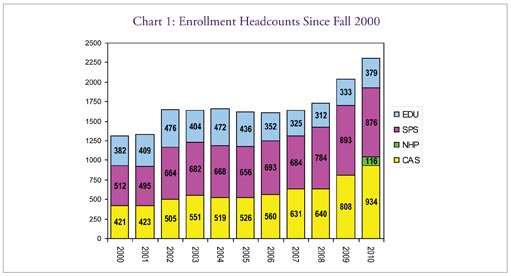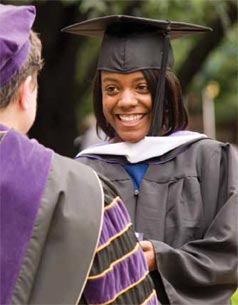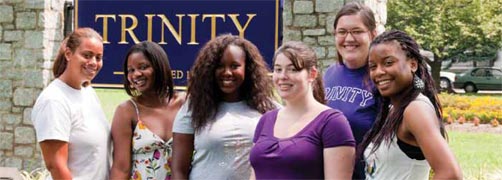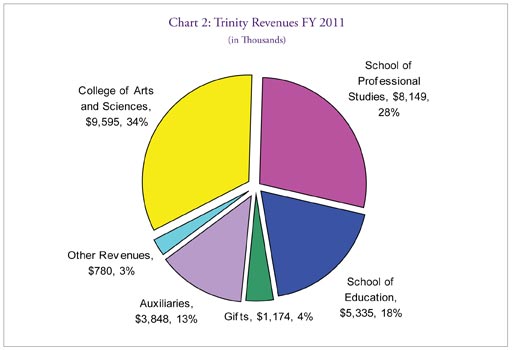2010 President’s Report
Trinity 2010:
Amazing Progress, Audacious Ambition

Trinity’s First Graduating Class: 1904
As I write this 2010 President’s Report, I can hardly believe that another ten years have come and gone since the Trinity community, benefactors and neighbors gathered to break ground for the Trinity Center for Women and Girls in Sports. On that memorable day in early November 2000, we concluded a remarkable three-year celebration of Trinity’s Centennial. We recalled our debt of gratitude to Sister Julia McGroarty and all of those courageous Sisters of Notre Dame de Namur who began this enterprise in the long hot summer of 1897. Three years after they executed the corporate documents and bought the parcel of land from Glenwood Cemetery that would become Trinity’s campus, they welcomed the first 19 students who began class on November 6, 1900.
Today, 110 years after that first class, we look back with profound gratitude for all of the visionary and generous souls who made Trinity what she has become: a vibrant university serving some of the most critical educational needs of our city; a growing women’s college attracting new generations of students determined to remake the landscape of their lives and communities; an innovative academic center increasingly well known for our work in general education and first year success; a great partner for so many other organizations in Washington, from the Girl Scouts to the Washington Hospital Center and National Rehabilitation Hospital to the Archdiocese of Washington and many other organizations.
Our past is glorious, and yet, it is prologue: Trinity’s future beckons ever more urgently as our more recent growth and success in new endeavors challenges Trinity to reach higher, faster, wider, more boldly and with greater confidence than ever before. Our plans for the future are ambitious and audacious.
This President’s Report necessarily provides the facts and figures about where Trinity has been recently, and where we stand in 2010. We are enjoying immense success. We have hit an all-time high of 2,305 students. The women’s college enrollment is back over 900 and growing. Our bottom line has never been healthier.
Even as we celebrate this great success, however, we know that we must take another great leap forward if we are to sustain Trinity’s achievements in the future. Developing our campus capacity to provide enough space for contemporary instructional and research needs is essential for Trinity to continue its role as one of the most innovative and forward-thinking universities in the Washington region.
One of Trinity’s very first students, Elsie Parsons, Class of 1904, later described what it was like to take up residence at Trinity in November 1900: “Who of us, I wonder, who witnessed the opening of Trinity…would have dared prophesy the future which is now her present and her past? A building hopelessly unfinished, a handful of brave religious, a little group of earnest students, a vast deal of that enthusiasm without which nothing great is ever accomplished, much kindly encouragement from friends, enough discouragement to ensure the stability of the undertaking and mark it with the indispensable seal of the Cross – those were the conditions under which it all happened.”
She goes on to describe the efforts of the first four students to find a door by which to enter the only part of Main Hall then erected – South Hall, which even then was unfinished. In their first months at Trinity, the students and sisters lived amid constant sawdust and hammers and doors awaiting windows. The unfinished Main Hall led those students to feel “…our responsibility as pioneers grow and increase within us.” No part of the building was finished, she wrote, “and many were the prophets of woe who asked how any one could possibly carry on classes in that place? What made it possible was the brave spirit of Sister Superior Julia…and the courage and generosity of that first community who faced positive hardship to make Trinity possible.” (Excerpt from archival records as quoted in Sister Columba Mullaly’s Trinity: The First 80 Years [1987], pp.66-67.)
Trinity remains a work in progress, unfinished in many ways, but still inspiring the heart and imagination of new generations of pioneers. The courage of our Founders lives on in the hard work and dedication of today’s faculty and staff. The spirit of generosity and faith of the Sisters of Notre Dame continues to inspire alumnae and benefactors to share vast amounts of time, talent and treasure to be sure this great enterprise continues to give witness to our world.
My gratitude is immense to all members of the Trinity family who continue the great work of more than a century past, to ensure that Trinity’s Second Century will be at least as ambitious and audacious as her First!

President Patricia McGuire
Trinity’s Strategic Design and Goals
Trinity’s 110th year is notable for several great achievements:
- Total university enrollment now stands at 2,305, the largest student body ever.
- Financial operations are “in the black” by a very comfortable margin.
- Thanks to the generosity of Phil and Mary McMahon Shannon ’60, the Shannon Challenge has encouraged great alumnae gifts from the Classes of 1960 through 1964.
- Trinity has added a fourth academic unit, the School of Nursing and Health Professions, and Trinity is planning expansion into the allied health professions as well as online programs.

Figure 1 shows the four academic units that now comprise Trinity’s academic design.
Each of these units has a dean and administrative staff, and all report to Provost Virginia Broaddus. The deans include:
Dr. Elizabeth Child, Dean of the College of Arts and Sciences
Dr. Telaekah Brooks, Dean of the School of Professional Studies
Dr. Antoinette Mitchell, Interim Dean of the School of Education
Dr. Mary Romanello, Dean of the School of Nursing and Health Professions
These four academic schools appeal to different student markets with different academic programs and delivery formats. While all of the schools support Trinity’s institutional mission and strategic goals, each unit also has its own distinctive mission and goals, including:
- The College of Arts and Sciences (CAS) is our historic Trinity College, the undergraduate women’s college serving students who are primarily 18-24 years old, attending full-time, majoring in disciplines rooted in the liberal arts. One-third of these students are residents this year.
- The School of Professional Studies (SPS) grew out of the Weekend College that began in the mid-1980s to serve working women in the Washington region. Today, SPS is coeducational and offers a full range of degree programs from the associate of arts through the baccalaureate and master’s levels, with courses offered at night and on weekends, and increasingly, online.
- The School of Education (EDU) began in the mid-1960s as the M.A.T. (Master of Arts in Teaching) program, and even at its start, the program was coed. Today, EDU offers a full range of graduate degrees in teaching, school leadership and counseling.
- The School of Nursing and Health Professions (NHP) is the newest unit, through which students are currently enrolled in the B.S.N. prelicensure program and the R.N.-to-B.S.N. for working nurses. In the future, NHP will add the M.S.N. and programs in the allied health professions.
Perhaps the most provocative dimension of Trinity’s transformation in the last two decades is the university’s success in sustaining the qualities that are historic Trinity hallmarks – the core values of honor and integrity, faith and the emphasis on social justice, personal care for each student, along with high expectations for academic excellence – while changing programs and organizational design to meet the needs of remarkably diverse new populations.
Alums often ask about traditions – class colors, Cap and Gown, Junior Ring, and others are alive and well and perhaps even more meaningful than ever among populations of students who feel a deep sense of belonging and community at Trinity. Equally urgent are the questions about the Honor System – and here again, the tradition has taken on new levels of meaning and importance as Trinity addresses the well-known ethical challenges presented by the Internet and other aspects of contemporary student life. Trinity’s Catholic tradition provides a strong thread weaving together a student body of many different faith traditions. For students coming to Trinity from public education, the opportunity to express faith openly is a welcome change.
Trinity’s student body is certainly different from prior generations in many ways. While the most notable difference may be demographic – nearly 90% of Trinity’s students today are African American, Latina, Asian or international – other differences are even more important for Trinity to address. More than 40% of Trinity’s students are from the District of Columbia, with another 30% from Maryland, and many come directly from public school systems that are well known for academic deficiencies. Trinity has not shied away from the challenge of educating students whose prior learning should have been better. Trinity takes it as a profound matter of mission, rooted in the social justice commitment of the Sisters of Notre Dame, to ensure that every student who can learn will have the opportunity to improve her life through the power of a great education. Our historic commitment to the education of women is also a matter of justice – we know what many public leaders keep discovering: that the education of women is essential to peace and the economic security of communities.
Enrollment
Trinity’s #1 strategic goal continues to be enrollment growth to build the university to a sufficient size to ensure sustainability in the future.

Chart 1 shows the growth in Trinity’s enrollment over the course of the last decade, since Fall 2000. This chart clearly shows several key growth areas:
- Overall, Trinity’s total enrollment has grown by 75% in the last ten years, from 1,315 enrolled in Fall 2000 to 2,305 in Fall 2010!
- Enrollment in the College of Arts and Sciences, our women’s college, has grown by 122% from just 421 students in Fall 2000 to 934 in Fall 2010.
- 116 students are now enrolled in the School of Nursing and Health Professions (the green section in 2010).

A Trinity student becomes an alumna.
How has Trinity been able to achieve this great enrollment growth, especially in the women’s college? Several key factors and strategic initiatives have propelled enrollment:
- A vibrant focus on student retention and student success has improved retention across all academic units, but none more dramatically than in the College of Arts and Sciences. Thanks to the leadership of Dean Elizabeth Child and the great work of the CAS faculty in implementing a new First Year Experience program that is now a national model, Trinity’s retention of first year students has improved 14 percentage points since Fall 2007.
- New programs have played a large role in attracting new enrollment, particularly nursing, criminal justice, international security studies, and the expansion of the traditional counseling programs beyond school counseling to include licensed professional counseling.
- Expanded financial aid for students through the D.C. Tuition Assistance Grants, D.C. College Access Program, D.C. Achievers Scholarships, and larger Pell Grants have all helped our local students take advantage of Trinity’s remarkable options for ambitious women.
- The Trinity Center for Women and Girls in Sports, opened in 2003, has had a substantial impact on enrollment in several ways:
- Better sports facilities have made it possible for Trinity to recruit young women who are fine students as well as excellent athletes; student athletes overall have higher grade point averages than the student body at-large;
- Modern facilities are very attractive to prospective students – even those who do not play sports see the Trinity Center as evidence of Trinity’s vibrancy and commitment to providing modern programs; this is an important factor to remember as we contemplate the new Academic Center;
- More than 30,000 visitors annually participate in events and programs at the Trinity Center, giving Trinity great visibility across many different constituencies. On any given day, visitors to the Trinity Center might encounter some of the 600 regular patrons of the pool and Fitness Center, to several thousand Girl Scouts attending step dances and honor programs, to youth soccer and basketball programs, tennis tournaments and even the New Zealand men’s rugby championship!

Members of Trinity’s Student Government Association
Financial Report
Successful enrollment strategies have also made it possible for Trinity to achieve financial goals. Trinity’s overall balance sheet improved by $4.7 million in Fiscal 2010 (to $58,573,525 total liabilities and net assets) largely as a result of the improved tuition revenues and stronger investment performance.
Trinity’s financial performance is benchmarked continuously against indicators derived from Moody’s ratings for similarly-sized private institutions and another set of indicators provided by the auditors at Brown Edwards. For Fiscal 2010, some of the highlights of the benchmarks include:
- Trinity’s return on net assets was 12.94% in Fiscal 2010, compared to the benchmark 4%;
- Trinity’s net income ratio was 8.04% compared to the benchmark of 3%;
- Trinity’s tuition discount was 28.9% compared to the benchmark of 36.1%;
- Trinity’s Composite Financial Index (CFI) was 4.23 compared to the benchmark of 3.5;
- Trinity is comfortably meeting all debt covenants on the Trinity Center bond.

How has Trinity been able to reach such a remarkable level of fiscal performance at a time when many arguably wealthier institutions are suffering deficits, layoffs and retrenchment in operations due to the ongoing effects of the recession? In fact, Trinity’s long experience with fiscal prudence made it possible for the university to weather the last few years of the external downturn quite well. Key factors working in Trinity’s favor during the recession include:
- Enrollment growth continued during the recession because many students found Trinity to be an affordable option compared to other private universities, and even some public institutions. Trinity works closely with students to develop good financial aid packages tailored to meet individual needs.
- Ironically, because Trinity’s endowment is quite small, Trinity has never relied on endowment income to balance the budget. While building endowment is a long-term goal to ensure fiscal stability, the discipline of having to live within earnings is an old habit at Trinity, unlike other institutions that are more used to drawing from endowment earnings to cover operating deficits.
- Trinity’s salaries and benefits are modest, and “perk” is a word reserved for the coffee urns. Trinity takes pride in maintaining an environment in which expenses are devoted to those areas that will contribute to student success and instructional improvements. Trinity has invested routinely in technology, ongoing plant improvements, faculty salary improvements and student aid; on the other hand, Trinity does not have large expenses for things like travel and entertainment, office furnishings beyond the basics, executive cars and expense accounts which can be considerable expense lines at other institutions.
Fiscal 2011 Budget
Trinity’s net operating budget for Fiscal 2011 is $28 million. The “net” does not include $6.5 million in Trinity grants, which are unfunded tuition discounts largely accorded to full-time students in the College of Arts and Sciences.

Chart 2 shows revenues for Fiscal 2011. $23 million, or 80% of the revenue budget, comes from student tuition. Auxiliary enterprises – the income from room and board, conferences and the Trinity Center – contributes another 13% to revenues. 4% of all revenues come from the Annual Fund and other gifts and grants.

Chart 3 shows expenses for Fiscal 2011. Salaries and benefits are the largest share of the budget, at roughly half of all expenses, and this proportion is somewhat less than at other universities where the proportion might be as much as 60%. Most of Trinity’s expenses are really fixed costs – the payroll, buildings, utilities, security and other expenses shown. After all of the fixed costs, just about 11% remains for “other” expenses that are everything from software and hardware, to books and subscriptions for the library, to legal and audit fees, to postage and printing, travel and conferences, and other similar kinds of expenses. This is a very modest budget given the size of Trinity today.

Financial Challenges
Trinity’s great Fiscal 2010 report is a product of much hard work and cooperation among all members of the campus community. At the same time, Trinity is challenged to sustain this momentum, and new investments are essential to ensure that the university continues to be able to deliver high quality programs to an increasingly broad range of students.
Heading into the second decade of the 21st Century, Trinity’s most serious financial challenges continue to be these:
- Developing the resources necessary to modernize and enlarge the capacity of the campus to meet the demands of contemporary instruction with an ever-larger student body enrolling in new and different programs that require new space configurations, e.g., nursing and allied health professions; enlarging the capacity of the campus is essential to meet Trinity’s strategic enrollment goals;
- Building endowment resources to provide the critical foundation to sustain Trinity’s fiscal backbone far into the future;
- Securing grant and scholarship resources sufficient to offset the $6.5 million in “unfunded” discounts that Trinity currently awards in student aid.

Building Trinity’s Second Century
On November 5, 2010 – 110 years after the first students took up residence in that “hopelessly unfinished” Main Hall – Trinity’s Board of Trustees took two actions that will ensure a long and vibrant future for Trinity:
- The Board approved plans for the $30 million Campaign for Trinity’s Second Century;
- The Board also approved the concept design for the new Trinity Academic Center.
Future editions of the TRINITY magazine and newsletters will include many more details about these historic decisions. Previous President’s Reports have hinted at these plans, and suffice to say that they have been in the works since the day we gathered to break ground for the Trinity Center, which was always intended as the first project of many to remake Trinity’s campus.
The Trinity Academic Center is essential for the future of this university. The concept design envisions a new integrated academic building housing classrooms and laboratories, a new auditorium, and, eventually, a new library. This new building will be sited on the south side of the campus currently occupied by the Library, Science Building and parking lots.
Even as we plan the new Academic Center, we also have plans afoot for improvements in Main Hall, notably, the long-desired second elevator, modernization of restrooms, and related improvements that will ensure Main Hall’s durability and functionality as we continue Trinity’s expansion.
Why now? Why not! The plans are ambitious and audacious. So is Trinity’s future. We undertake the task of building the foundation for Trinity’s second century with the lessons of our Founders fixed clearly in our memory. They persisted and succeeded. With their inspiration and blessings, we will do the same for the future generations of Trinity.
